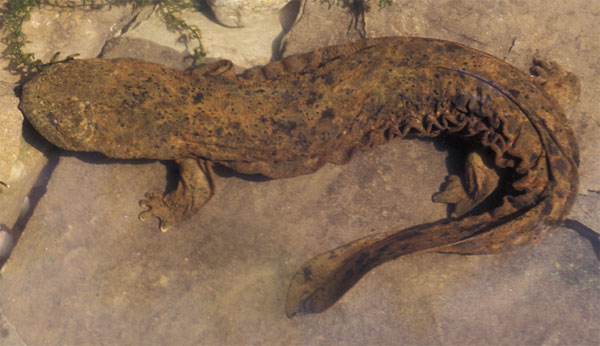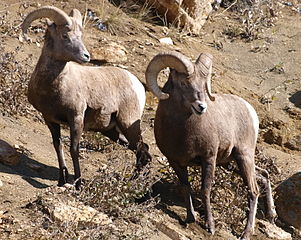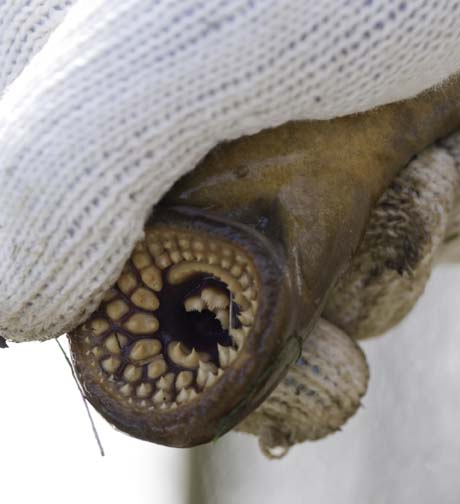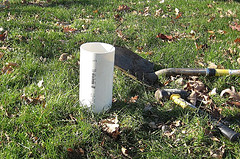A homeowner in Colfax, Cal. has found five dead deer in her yard since September. A local veterinarian suspects that it might be adenovirus. However, the homeowner apparently called her local newspaper before reporting the deer to the California Department of Fish and Game, so while we know the deer are dead, no tests have been done.
Monthly Archives: November 2011
Georgia Surveys Hellbenders
North Georgia has one of the healthiest eastern hellbender populations in North America. The Georgia Department of Natural Resources Wildlife Resources Division began a long-term survey and monitoring project of the large salamanders this year.
Using nets, sometimes snorkeling, the research team surveyed stream segments in four watersheds this season, ending last month. The hellbenders found were weighed, measured, swabbed amphibian diseases, sampled for DNA and tagged with Passive Integrated Transponders (PIT).
The purpose of the study is to establish baseline data for the species in the state.
Like the Ozark hellbender, which was listed as federally endangered last month, the eastern hellbender has experienced sharp population declines. It is state-listed as threatened in Georgia and has already disappeared from eight streams where it was once found in the state.
The eastern hellbender is found in 12 states ranging from southern New York to northern Mississippi, with a western population in Missouri.
Get all the details in the Georgia Department of Natural Resources press release, here.
Also read about previous eastern hellbender research in New York State, here.
Photo courtesy of Pennsylvania Boat & Fish Commission
Burro Removal in Texas
It’s the wild horse controversy, served up Tex-Mex style, with shorter legs and longer ears. The Texas Parks and Wildlife Department is shooting wild burros found on state land in the Big Bend region. The burros have their advocates, and even on the adjoining Big Bend National Park, it is illegal to hunt the wild burros, which are not a native species, but are considered to be historically significant.
Read the Associated Press story on the controversy, which emphasizes the conflict between native bighorn sheep, prized by wealthy hunters, and the lowly burros, embraced by animal-lovers across class lines. Here’s the story in the New York Times. (But if you are trying to keep under your monthly article limit, here is the same story in the Washington Post.)
The Wildlife Society’s position is that burros are not native, and the feral animals need to be managed responsibly. Read the organization’s comment here.
Bighorn Vaccine Can’t Cure Sheep Lease Controversy
A year ago the Payette National Forest, in west-central Idaho, announced it was going to cut back on leases to domestic sheep ranchers to reduce the risk of a pneumonia-like disease spreading from the domestic sheep to the local, native bighorns.
Earlier this year a Washington State University researcher announced that he had developed a vaccine to protect the bighorns from the disease. That was wonderful news to an Idaho congressman, who introduced a rider to an appropriations bill that would delay the revocation of the sheep grazing leases for five years.
But in a letter to his funders, the WSU researcher said the bighorn vaccine is still 10 years from practical application. (Read more in the Lewiston Tribune.) This week a consortium of wildlife groups urged the congressman to withdraw his rider. (Read about it in the Idaho Statesman.)
The implications are bigger than Payette National Forest. The congressman has said that his rider merely stops other national forests from cutting back on their domestic sheep leases to protect bighorns from disease. (Read about it, again, in the Idaho Statesman.)
Photo by Ingrid Taylor (http://www.flickr.com/photos/taylar/) Colorado bighorn sheep
Dead Lamprey Juice May Be The Answer
Sea lampreys are the source of much angst among wildlife biologists. Are they native to this body of water? How long have they been here and where did they come from? In many locations, including the Great Lakes, sea lampreys are a huge problem that must be dealt with.
Lampricide, in theory at least, kills larval lamprey but doesn’t harm other stream residents. However some other species are sensitive, and there are always those native, non-trouble-making lamprey to worry about. Dams — temporary and permanent — across breeding streams have been tried, too.
The latest weapon in the war against invasive sea lamprey may be the odor of the decaying lampreys themselves.
Research at Michigan State University showed that the “stink” was easily extracted from rotting lampreys in the lab. Lampreys in tanks and swimming in raceways avoided areas that were treated with the dead lamprey extract.
The dead lamprey juice’s most likely use will be to deter lamprey from certain sensitive breeding streams. Or, it may be used to concentrate lamprey into a few streams so that lampricide applications can be more effective.
Field tests will be conducted this summer.
Read the open-access paper in the Canadian Journal of Fisheries and Aquatic Sciences, here.
Read the Michigan State press release here.
Read an article in the Milwaukee Journal-Sentinel here.
Photo by Kurt Stepnitz, courtesy of Michigan State University
Elk Collared in Colorado
Can Colorado have both sunflower agriculture and healthy elk and deer herds? That’s the aim of research by Colorado Parks and Wildlife. The three-year project will track 20 elk and 20 deer to learn their migration patterns. The contractor, Quicksilver Air of Alaska used a helicopter and net gun to capture the animals.
The results of the study will allow wildlife biologists and farmers to come up with a plan to keep the elk and deer away from the sunflower crop. The state pays half a million dollars a year to farmers for crop damages, says an article in the Durango Herald.
The detailed article also says that the project will cost $275,000. Similar contractors, the article notes, charge anything from $500 an animal to $1,600 per hour for their services. The collars cost about $3,000 apiece.
Read the article in the Durango Herald here.
Photo: 3268zauber
Nevada Pulls Up PVC Stakes to Save Birds
PVC pipes are cheap, light and visible from a distance. They are used all over the country as stakes to mark everything from foundation contours to mining claims. In Nevada, it’s the mining claim stakes that are the problem.
Ground nesting and cavity nesting birds are flying into the pipes, thinking they are nesting sites. But the birds don’t get out, because the pipes’ smooth interior doesn’t give them anything to grab on to. The Red Rock Audubon Society says that thousands of birds have died in Nevada in these PVC pipes. They say that bees and lizards are also trapped and die in the pipes.
It’s been illegal to mark a mining claim with an uncapped PVC pipe in Nevada since 1993, but the law has been ineffective. A new state law, SB 108, took effect last week. It allows citizens to remove upright, uncapped PVC pipes on inactive mining claims or place the stake on the ground nearby if the claim is active.
Read about the hazards of PVC pipe markers from the Red Rock Audubon Society. News of the bill’s passing is here.
Read an article in the Las Vegas Review-Journal about the new law.
Here’s the text of the law as it was actually enacted. You can see the whole history of the bill, including the wording when it was introduced, here.
The law requires that the pipes, whether metal or PVC, be capped or crimped at the top. Comments on the Review-Journal article point out that filling the pipes with dirt would also protect birds, bees and lizards from the pipes too. Claim holders had three years to cap or crimp their pipes before the clause that allows citizens to pull them up took effect.
Photo: plerophoria67 on Flickr
Nevada Pulls Up PVC Stakes to Save Birds
PVC pipes are cheap, light and visible from a distance. They are used all over the country as stakes to mark everything from foundation contours to mining claims. In Nevada, it’s the mining claim stakes that are the problem.
Ground nesting and cavity nesting birds are flying into the pipes, thinking they are nesting sites. But the birds don’t get out, because the pipes’ smooth interior doesn’t give them anything to grab on to. The Red Rock Audubon Society says that thousands of birds have died in Nevada in these PVC pipes. They say that bees and lizards are also trapped and die in the pipes.
It’s been illegal to mark a mining claim with an uncapped PVC pipe in Nevada since 1993, but the law has been ineffective. A new state law, SB 108, took effect last week. It allows citizens to remove upright, uncapped PVC pipes on inactive mining claims or place the stake on the ground nearby if the claim is active.
Read about the hazards of PVC pipe markers from the Red Rock Audubon Society. News of the bill’s passing is here.
Read an article in the Las Vegas Review-Journal about the new law.
Here’s the text of the law as it was actually enacted. You can see the whole history of the bill, including the wording when it was introduced, here.
The law requires that the pipes, whether metal or PVC, be capped or crimped at the top. Comments on the Review-Journal article point out that filling the pipes with dirt would also protect birds, bees and lizards from the pipes too. Claim holders had three years to cap or crimp their pipes before the clause that allows citizens to pull them up took effect.
Photo: plerophoria67 on Flickr
Grassland Research Grants
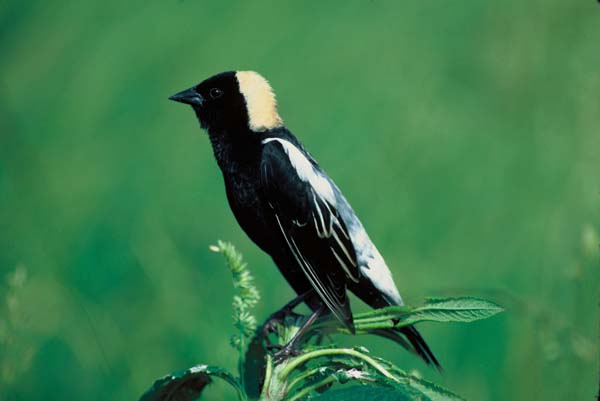 |
| Bobolink, a grassland bird, courtesy of the US Fish and Wildlife Service |
Grants of up to $1,000 to study prairies and savannas are available from Prairie Biotic Research, a Wisconsin nonprofit organization.
The good news is that these small grants support both natural history and experimental science for any grassland taxon anywhere in the U.S. The bad news (for state wildlife biologists) is that the program is “eager to support” independent researchers. But anyone is welcome to apply. At worst, you can pass this information along to your favorite independent grasslands researcher, and come out a winner anyway.
For more about the organization and past grants, visit the Web site.
For the Prairie Biotic Research’s announcement, follow this post after the break.
FUNDING FOR PRAIRIE RESEARCH
offered by Prairie Biotic Research, Inc.
We Are
Prairie Biotic Research (PBR) is an all-volunteer, Wisconsin nonprofit established in 2000 to foster basic biotic research in prairies and savannas. One way we do this is through a competitive Small Grants Program that funds grants up to $1,000 to individuals for the study of any grassland taxon anywhere in the USA. We support both natural history and experimental science.
We are especially eager to support independent researchers (those lacking institutional support), but anyone may apply. Since 2002, we’ve awarded 100 grants worth $94,849 to people in 24 states to study insects, plants, mammals, reptiles, slime molds, mycorrhizal fungi, spiders, snails, amphibians, invasive species, and effects of management. Many of these grants supported graduate student research.
In 2011, we expect to fund at least 12 grants of up to $1000 each with the donations we have received, including some restricted by donors to support research in the Upper Midwest and in Missouri, where research on Missouri Prairie Foundation properties is of special interest.
To Apply for a Grant
Visit our website (prairiebioticresearch.org) to learn more, to download our proposal form, instructions, and a sample researcher agreement form that winners of this competition must sign. Check out the history and overview files in the Small Grants section of the website to see what sorts of proposals have won funding in the past. Review the reports submitted by researchers of past years.
We must receive your proposal through the mail before January 7, 2011. Those who won funding in 2010 are ineligible for this funding in 2011, but those who won funding longer ago are welcome to submit proposals to further that same work or to support a new project.
Our Supporters
We are grateful for gifts recently received from individuals, foundations and nonprofit organizations in support of our Small Grants Program: Andria Blattner, Kurt Christoffel, Citizens Natural Resources Association of Wisconsin, Robert & Nancy Dott, James E. Dutton Foundation, Hildy Feen, Tamara Felden, Catherine Gimse-Owen & Robert Owen, Don & Helen Hagar, MJ Hatfield, Hillsdale Fund, George & Marilyn Johnson, Kyle Johnson, Herbert H. Kohl Charities, Roma Lenehan, The Fred Maytag Family Foundation, Emily & Richard Moore, Connie Mutel, The R. D. and Linda Peters Foundation, Ursula Petersen, Irwin Andrew Porter Foundation, Ron Priest, Dennis Schlicht, Jim & Rose Sime, The Paul E. Stry Foundation, Glenn Teschendorf, Elaine & Richard Tinberg, Tom & Eva Wedel, Andrew Williams, and Ken Wood.
Become a Supporter
Please make a donation to support PBR. Any amount is welcome. PBR is volunteer-run so our overhead is very low. You may specify that your entire tax-deductible donation be given to researchers through our Small Grants Program, or to expand our research endowment that produces income we give away annually through this program.
Please help us to help others!
Michael Anderson, Craig Brabant, Rebecca Christoffel, Jaime Edwards, Brick Fevold, Kerry Katovich, Douglas LeDoux, Victoria Nuzzo, Ursula Petersen, Dennis Schlicht, Scott Swengel, David Voegtlin, Andrew Williams, and Daniel Young, who comprise the Board of Directors and Scientific Advisors of Prairie Biotic Research, Inc.
“We Foster Curiosity”
Rebecca Christoffel
Assistant Professor and Extension Wildlife Specialist
Iowa State University
Department of Natural Resource Ecology and Management
339 Science II
Ames, Iowa 50011
(515) 294-7429
christof@iastate.edu
Gold: A New Threat to U.S. Streams
With gold at $1,600 an ounce, recreational gold panners are getting serious — serious enough to have an impact on stream environments. That’s the case in North Carolina, where a local land trust closed its property to gold prospectors recently, and the Uwharrie National Forest banned suction dredging several years ago.
Read the story in the Charlotte Observer, here. (Oh, and you’ll have to forgive the headline, which refers to “marine life.” Clearly, the article is referring to aquatic life in central North Carolina, far from the ocean.)
Think that no one is panning for gold in your state? Think again. Placer gold, the kind found in stream sediments, has been found in just about every state. Panning for gold is sometimes unregulated, and where it is regulated, misconceptions and plain old ignorance abound. The real damage comes from mechanized panning, such as suction dredging.
Is the critical habitat for your sensitive aquatic species safe from gold panning?

